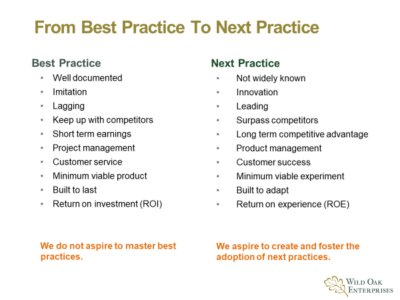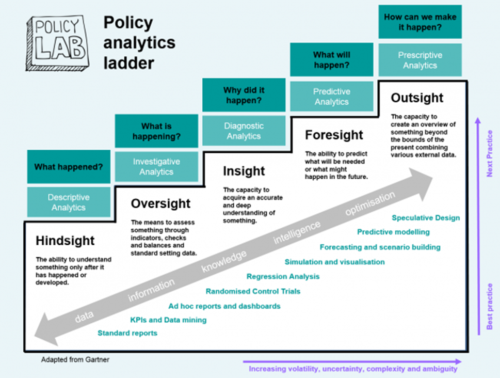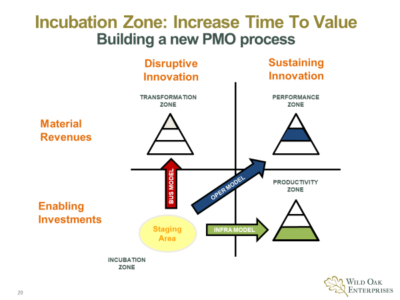
May 25, 2022
In the digital world,
next practices beat best practices

Are you creating the last best version of the old model or the first best version of the new model?
Disruptive change not only increases stress, uncertainty, and risk but it also enables individuals to retreat to what they know rather than explore what they don’t know. This is not only a death knell to successful new innovations, but it also undermines building a culture of creativity and collaboration.
The scope and speed of disruption from digital technologies is forcing companies to discover new ways to engage with their customers, employees, supply chain partners, and even their competitors. The five waves of digital disruption (social, mobile, cloud, data analytics, and connected devices) are completely altering how people connect, communicate, and discover information. These new tools affect how customers make decisions, which affect their entire customer journey, which ultimately affects their customer lifetime value.
To successfully compete in this new environment, you have to build an organizational culture that excels at discovering and implementing the next practice rather than relying on an existing best practice.
What’s the difference between next practices and best practices?

The Executive Next Practices Institute, a think-tank of hundreds of top executive and thought leaders, have described the differences this way:
- Best practices are past driven – repetitive formulas for tactical business problems.
- Next practices are future-driven strategic solutions that enable you to better anticipate and respond to disruptive issues that have embedded uncertainties, risks, and variables.
In my work with C-Suite Executives, we have developed our own descriptions of the difference between best and next practices as shown on the chart below:

From hindsight to outsight
The Centre for Public Impact’s Policy Lab is focused on developing better ways to discover next practices to build on and contribute to best practices. They describe each one this way:
- “Best practice seeks and explores what works by looking for something that has been done before and is therefore successfully proven.”
- “Next practice in contrast has no precedent, it is future focused and therefore has many unknowns and ambiguities.”
They believe that bridging different disciplines, crossing organizational boundaries and artificial silos is important to successfully discovering and successfully implementing next practices. They deploy a series of different analytics tools in their progressive search for next practices, shown on the chart below with 5 steps from “hindsight” to “outsight”.

A framework and game plan for moving from best practices to next practices

Even in the face of the disruptive impact of new digital technology, most companies still identify and measure their performance against industry best practices. Adopting existing practices can incrementally improve the performance of your current operating model but it can’t address the need to transform your business model.
To go beyond your current business model requires reimagining how your company will deliver value as a digital enterprise. This requires gaining knowledge and confidence that your organization can successfully deploy new digital technologies. It also allows you to have the courage to prioritize long term growth over short term earnings. Here are 4 ways to get started:
- Raise your company’s digital acumen: Uncertainty feeds off a lack of knowledge and understanding about what’s new and what’s possible. To lower uncertainty, create a continuous learning program to enable your board, executive committee, and senior leadership teams to better understand the scope and disruptive impact new digital technologies can have on your company.
- Engage with early adopters: Seek out opportunities to meet with executives from startups and well-established companies who are pioneering next practices and see what you can learn from them. They likely faced the same operating and cultural challenges you are, so learning how they overcame them will be invaluable.
- Change your compensation structure: It’s a cliché but still very true – people do what they get paid to do. If you’re still incentivizing business units to only deliver short term returns then you can’t expect them to commit to redirecting resources to longer term payout initiatives. Every salesperson I know is primarily motivated by a desire to “make club.”
- Develop a compelling narrative for investors: As the statistics highlight, the market does like and will reward successful business model pivots that deliver long term value. As such, be very clear about your intentions and your game plan to successfully realize those intentions.
More recently I have been working with digital technology innovation teams using the 4 Zones Model framework shown below to prioritize and manage a portfolio of business innovation projects. This approach has accelerated the identification and prioritization of next practices that disrupt the current competitive landscape across multiple markets and industry sectors.
Sustaining innovations enable the more efficient operation of your existing businesses while disruptive innovations enable you to create next practice businesses.

With this approach, the incubation zone is used as a staging area to prioritize all business innovation initiatives. Each initiative is first segmented using the following questions:
- Are they sustaining innovations or disruptive innovations?
- Are they enabling systems productivity and cost optimization?
- Are they increasing business unit operating performance and revenue growth?
- Are they enabling business model transformation?
The result of this exercise allows you to see what percentage of your resources and budget are allocated to maintaining best practices versus creating and deploying next practices. It also provides for an open and honest discussion about the overall risk tolerance your organization is willing to undertake.
Some next practices to help you win the business innovation wars
In working with different companies over the past several years to help them hone their business innovation skills, I have seen a series of next practices that increase the odds of winning the business innovation wars.
- You need to gain cross-enterprise alignment and support for a digital-first business growth strategy and implementation plan.
- The competitive landscape is changing so fast that anything less than an all-in approach will likely fail.
- You need to create a culture of continuous learning and experimentation and be willing to fail fast and learn fast.
- You need to excel at segmenting competing innovation options using the 4 Zones framework.
- You need to be able to leverage data and analytics to identify and create entirely new customer services and experiences.
- You need to be able to construct and orchestrate business partner networks and ecosystems that leverage the competitive benefits of assets you don’t own and directly control.
- You need to have the resolve to sacrifice short term revenue and earnings in order to create sustainable long term competitive advantage.
The business environment is littered with examples of companies who could not catch the next wave of digital disruption. If you are a leader who has the vision, resolve, and commitment to find and implement next practices, I’d welcome the opportunity to help you achieve that goal.
As always, I am interested in your comments, feedback and perspectives on the ideas put forth in this blog. Please e-mail them to me on linkedin. And, if this content could be useful to someone you know please share it here:



